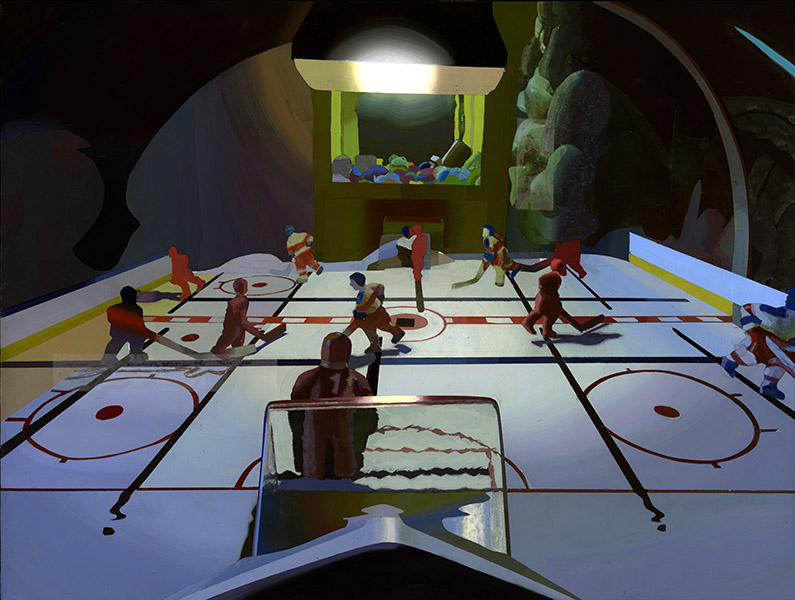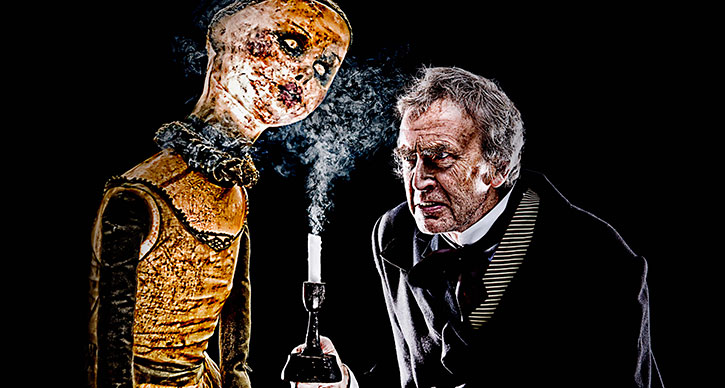UMS Artist in Residence Update: New Paintings by Siobhan McBride
Editor’s note: Siobhan McBride is a visual artist and one of our 2015-2016 artists in residence. As part of this program, artists in residence attend UMS performances to inspire new thinking and creative work within their own art forms. Siobhan attended A Christmas Carol, by the National Theatre of Scotland. Below is her response to the performance.
Here are a couple of paintings I’ve been working on recently:


Photos: New painting by Siobhan McBride.
I’ve always felt more comfortable in enclosed spaces. I prefer my back to the wall in restaurants, booths rather than tables, sleeping bags, attic spaces, small groves of trees, the geometry of a clam shell. A trapped elevator scenario causes me no grief.
In a large studio I once occupied, I built a cave out of paper mache and chicken wire, simply furnished with a busted short-legged upholstered chair. I used it as a panic room. A place to curl up, read, obsessively playback unfortunate social interactions, or nap. A space that denied attackers the advantage of surprise. Likewise, the spaces in my paintings tend to feel compressed, close. I like flatness, painted elements pressed forward, tectonically still, or shallowly shuffling like playing cards.
The hockey painting is unfinished. It has a distinctly differently space than many of my other paintings, perhaps influenced by recently seeing a number of performances on stages at Hill Auditorium and the Power Center as part of the UMS residency. The sense of enclosure is present in the painting, but more vaguely so.
I’ve always been fond of creating scenes from a seemingly hidden vantage point, like a hunting blind, a battlement, seeing without the burden of being seen. A different kind of enclosure, that is apart from the scene rather than within it.

Photo: Scene from A Christmas Carol. Photo courtesy of the artists.
In December, I saw A Christmas Carol performed by the National Theatre of Scotland. The set was small and tight (my ideal viewing situation!) and the presence of haze allowed me to literally disappear in a puff of smoke while I enjoyed some amazing, often alarming puppets and the details of their incredible set.
Interested in more? Follow the adventures and process of other UMS Artists in Residence.
Building Scrooge’s Office
Installing a Victorian counting house inside a modern auditorium:
National Theatre of Scotland’s A Christmas Carol is in Ann Arbor’s Power Center December 17-January 3, 2016.
Director’s Note: A Christmas Carol
National Theatre Scotland’s A Christmas Carol is at Power Center, within a special set on stage, December 17-January 3, 2016. Only 150 audience members per show join Ebenezer Scrooge in his Victorian counting house and sit in creepy close-up as this most famous of misers is visited by three ghosts during his night of soul-searching.
Below, director Graham McLaren shares his take on Charles Dickens’s classic fable.

Photo: Moment in A Christmas Carol. Photo by Mark Hamilton.
It is said that Charles Dickens, along with Prince Albert who introduced the Christmas tree and the Christmas card to Britain, helped to create our idea of Christmas about 150 years ago. If he did, it’s more likely that was a by-product from the success of his story, not its primary aim. Yes, it is set at Christmas time and takes the form of a fable or carol, but its contents deal with social injustice and result in a cry for change and direct action.
On behalf of the poor man’s child
While it may be true that Dickens wrote his story in 1843, the same year in which the first ever Christmas card was created and sent, more significant is that it was also the year of the publication of a report by the Children’s Employment Commission. This report was a detailed and damning account of the appalling working conditions that children suffered at the time, and so inflamed him that he started to write a pamphlet called An Appeal to the People of England, on Behalf of the Poor Man’s Child. He abandoned it when he realized he needed a more popular form to reach the masses. So he wrote the story of an old man with a heart as cold as winter itself. He has such a terrible night alone with his conscience that he learns to treat his fellow men and women with kindness, generosity and compassion, gaining a reputation as a man who embodies the very spirit of Christmas.
It is, however, the way Dickens writes his vision of the world that leaves its inky scratches on our memory. Even the very best of Dickens illustrators such as Cruikshank and Phiz can’t begin to capture the grotesque characters that haunt his work.
Politics and atmosphere
The challenge for us, in creating this production for you, has been: how do we best serve Dickens’ social and political agenda, and at the same time create the extraordinary atmosphere that his story demands? It is this question that guided us through the process of creating this show, and led us, for instance, to the use of puppetry for the ghosts and visions, and our desire to bring you close to the action by surrounding you with the set.
In developing our version of this enduring tale, we concentrated on what I believe to be the very heart of the story, where Scrooge asks The Ghost of Christmas Present: “What is that protruding from your skirts—is it a foot or a claw?” The Ghost responds with a warning that these children are “Ignorance” and “Want” and to “Beware them both, but most of all beware the boy for on his brow I see that written which is Doom.”
We wanted to challenge all notions of sentimental stage and screen adaptations of A Christmas Carol, and so kept returning to Dickens’ writings in an effort to be true to his appeal “on behalf of the poor man’s child.” We hope you enjoy it.
Your presence is requested at the offices of Messrs. Scrooge and Marley December 17-January 3.


